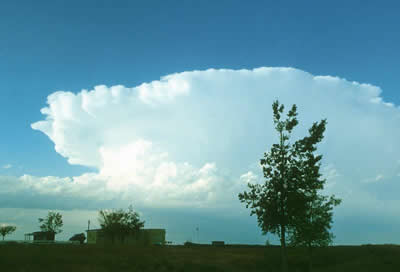The GOES-M satellite was launched aboard this Atlas rocket on July 23, 2001, from Cape Canaveral.
Click on image for full size
Courtesy of NASA
U.S. Launches Their Most Advanced Satellite Today
News story originally written on July 23, 2001
The GOES-M satellite was launched early this morning. This new satellite will track two kinds of weather:
weather here on Earth like
thunderstorms,
hurricanes, and floods
and
space weather.
Space weather happens outside the Earth's atmosphere, but it can have a big effect on Earth. Space weather can endanger astronauts in space, fry satellites that carry your cable or radio stations, and fry power grids here on Earth. The GOES-M satellite is carrying the Solar X-ray Imager (SXI) instrument. This instrument is the most advanced instrument of its kind and it will help scientists forecast this space weather just like scientists forecast the Earth's weather.
You might also be interested in:

Thunderstorms are one of the most exciting and dangerous types of weather. Over 40,000 thunderstorms happen around the world each day. Thunderstorms form when very warm, moist air rises into cold air.
...more
Hurricanes form in the tropics over warm ocean water. The storms die down when they move over land or out of the tropics. At the center of the rotating storm is a small area of calm weather and clear skies
...more
It was another exciting and frustrating year for the space science program. It seemed that every step forward led to one backwards. Either way, NASA led the way to a great century of discovery. Unfortunately,
...more
The Space Shuttle Discovery lifted off from Kennedy Space Center on October 29th at 2:19 p.m. EST. The sky was clear and the weather was great. This was the America's 123rd manned space mission. A huge
...more
Scientists found a satellite orbiting the asteroid, Eugenia. This is the second one ever! A special telescope allows scientists to look through Earth's atmosphere. The first satellite found was Dactyl.
...more
The United States wants Russia to put the service module in orbit! The module is part of the International Space Station. It was supposed to be in space over 2 years ago. Russia just sent supplies to the
...more
A coronal mass ejection (CME) happened on the Sun last month. The material that was thrown out from this explosion passed the ACE spacecraft. ACE measured some exciting things as the CME material passed
...more















